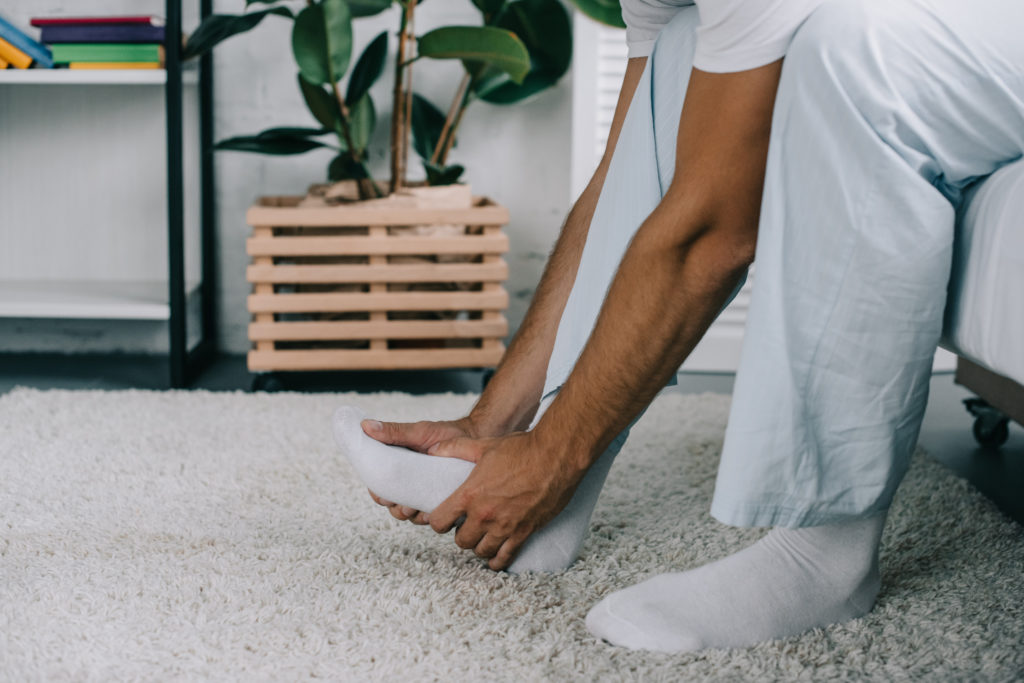THIS POST IS PART OF THE ULTIMATE GUIDE TO FOOT AND ANKLE INJURIES
A lisfranc injury, also referred to as a midfoot injury, occurs when the bones in the midfoot are broken or ligaments that support the midfoot are torn.
This can cause pain, swelling and pain on the top and bottom of your foot. A lisfranc foot injury can slow down your life and you should seek a diagnosis from an OrthoIndy foot and ankle specialist.
Foot Anatomy
Your feet contain nearly one-fourth of all the bones in your body, which provide you with lots of support and movement. There are 26 bones in one foot: 14 toe bones, five long metatarsal bones and seven tarsal bones.
The midfoot is the middle region of the foot, where the arch is on the top of your foot. The function of the midfoot is critical for walking as it transfers the forces generated by the calf muscles to the front of the foot.
A twisting fall can break or dislocate this cluster of bones and ligaments in your midfoot. Injuries vary from affecting only a single joint in the midfoot to a complex injury that harms multiple joints and ligaments.
DOWNLOAD THE ULTIMATE GUIDE TO FOOT AND ANKLE INJURIES >
Lisfranc Foot Fracture Causes
A lisfranc foot injury is usually caused by some sort of accidental fall or trauma to the foot. This injury is common in football and soccer players and athletes who play contact sports. It can also occur in a motor vehicle accident.
Some common accidents that cause a lisfranc fracture include:
- Twist and fall
- Fall from a height
- Car accident

Lisfranc injury symptoms
A lisfranc joint injury results in pain and swelling from your initial fall or accident. The severity of your symptoms will correlate to how bad your injury is and how long ago it happened.
Some other symptoms include:
- Pain that worsens with standing or walking
- Bruising on the top and bottom of the foot
- Top of foot is swollen and in pain
- Inability to put weight on your foot or ankle
How bad is a lisfranc injury?
To determine whether you have a midfoot injury and its severity, your foot and ankle physician will ask you for a complete medical history, have you describe your symptoms and how the injury occurred and conduct a physical examination. An X-ray, MRI or CT scan may be necessary to rule out other problems.
MAKE AN APPOINTMENT WITH A FOOT AND ANKLE SPECIALIST AT ORTHOINDY
Can a Lisfranc injury heal on its own?
Lisfranc injury treatment depends on the cause and severity of your injury. Your foot and ankle specialist will determine with you the best course of treatment for your case. A lisfranc injury is very serious and should be treated immediately so it doesn’t cause complications later in life.
Nonsurgical treatment is possible if there are no fractures or dislocations in the joint and the ligaments are not completely torn. During treatment, a patient will wear a cast or boot for six weeks before progressing to weight bearing in a removable boot or orthotic. Regular visits with your orthopedic specialist will ensure proper healing.
Lisfranc injury surgery is necessary when there is a fracture present in the joints of the midfoot or if the joints are out of place. Surgery will realign the joints. The type of surgery depends on the severity of the injury.
Lisfranc Injury Surgery Risks
Although surgical treatment for a lisfranc injury has very few complications, with any surgery comes risk.
If there was damage to the cartilage during your accident or fall, there is a high risk of arthritis occurring later in life. This may cause chronic pain in your foot and you may need a fusion in the future.
Lisfranc injury recovery time
After surgery, you will not be allowed to bear weight for six to eight weeks and your foot will be in a cast or cast boot. Weight-bearing begins when your X-rays show the bones are healing correctly. Your surgeon will let you know how long you are allowed to walk and when.
Athletes should talk to their foot and ankle physician before resuming sports activities. It may take a few months to get back the level of play you were at previously.
Schedule an appointment
Your well-being is important to us. Click the button below or call us to schedule an appointment with one of our orthopedic specialists. If your injury or condition is recent, you can walk right into one of our OrthoIndy Urgent Care locations for immediate care. For rehabilitation and physical therapy, no referral is needed to see one of our physical therapists.





